The Influence of Forward Osmosis Module Configuration on Nutrients Removal and Microalgae Harvesting in Osmotic Photobioreactor
Abstract
1. Introduction
2. Materials and Methods
2.1. Microalgae Strain and Pre-Cultivation
2.2. Synthetic Wastewater and Draw Solution Chemistry
2.3. FO Membrane
2.4. Experimental Setup and Protocols
2.4.1. Experimental Setup
2.4.2. Osmotic PBR Operation with Synthetic Wastewater
2.5. Sampling, Analytical Methods and Calculation
3. Results and Discussion
3.1. Salt Accumulation
3.2. Biomass Analysis
3.3. Nutrients Removal in PBR Integrated with Different FO Configurations
3.4. Water Flux Decline during Dewatering of C. vulgaris by FO Membrane
4. Conclusions
Author Contributions
Funding
Data Availability Statement
Acknowledgments
Conflicts of Interest
References
- Jones, E.R.; van Vliet, M.T.H.; Qadir, M.; Bierkens, M.F.P. Country-level and gridded estimates of wastewater production, collection, treatment and reuse. Earth Syst. Sci. Data 2021, 13, 237–254. [Google Scholar] [CrossRef]
- Gonçalves, A.L.; Pires, J.C.M.; Simões, M. A review on the use of microalgal consortia for wastewater treatment. Algal Res. 2017, 24, 403–415. [Google Scholar] [CrossRef]
- Wang, S.; Ortiz Tena, F.; Dey, R.; Thomsen, C.; Steinweg, C.; Kraemer, D.; Grossman, A.D.; Belete, Y.Z.; Bernstein, R.; Gross, A.; et al. Submerged hollow-fiber-ultrafiltration for harvesting microalgae used for bioremediation of a secondary wastewater. Sep. Purif. Technol. 2022, 289, 120744. [Google Scholar] [CrossRef]
- Gandiglio, M.; Lanzini, A.; Soto, A.; Leone, P.; Santarelli, M. Enhancing the Energy Efficiency of Wastewater Treatment Plants through Co-digestion and Fuel Cell Systems. Front. Environ. Sci. 2017, 5, 70. [Google Scholar] [CrossRef]
- Singh, P.; Carliell-Marquet, C.; Kansal, A. Energy pattern analysis of a wastewater treatment plant. Appl. Water Sci. 2012, 2, 221–226. [Google Scholar] [CrossRef]
- EPA, U. Energy Efficiency for Water Utilities. 30 March 2022. Available online: https://www.epa.gov/sustainable-water-infrastructure/energy-efficiency-water-utilities (accessed on 13 August 2022).
- An, J.-Y.; Sim, S.-J.; Lee, J.S.; Kim, B.W. Hydrocarbon production from secondarily treated piggery wastewater by the green alga Botryococcus braunii. J. Appl. Phycol. 2003, 15, 185–191. [Google Scholar] [CrossRef]
- Hom-Diaz, A.; Jaén-Gil, A.; Bello-Laserna, I.; Rodríguez-Mozaz, S.; Vicent, T.; Barceló, D.; Blánquez, P. Performance of a microalgal photobioreactor treating toilet wastewater: Pharmaceutically active compound removal and biomass harvesting. Sci. Total Environ. 2017, 592, 1–11. [Google Scholar] [CrossRef]
- Chen, Z.; Xiao, Y.; Liu, T.; Yuan, M.; Liu, G.; Fang, J.; Yang, B. Exploration of Microalgal Species for Nutrient Removal from Anaerobically Digested Swine Wastewater and Potential Lipids Production. Microorganisms 2021, 9, 2469. [Google Scholar] [CrossRef]
- Nwoba, E.G.; Ayre, J.M.; Moheimani, N.R.; Ubi, B.E.; Ogbonna, J.C. Growth comparison of microalgae in tubular photobioreactor and open pond for treating anaerobic digestion piggery effluent. Algal Res. 2016, 17, 268–276. [Google Scholar] [CrossRef]
- Gudin, C.; Thepenier, C. Bioconversion of solar energy into organic chemicals by microalgae. Adv. Biotechnol. Processes 1987, 6, 73–110. [Google Scholar]
- Cath, T.Y.; Childress, A.E.; Elimelech, M. Forward osmosis: Principles, applications, and recent developments. J. Membr. Sci. 2006, 281, 70–87. [Google Scholar] [CrossRef]
- Bilad, M.; Arafat, H.A.; Vankelecom, I.F. Membrane technology in microalgae cultivation and harvesting: A review. Biotechnol. Adv. 2014, 32, 1283–1300. [Google Scholar] [CrossRef]
- Larronde-Larretche, M.; Jin, X. Microalgae (Scenedesmus obliquus) dewatering using forward osmosis membrane: Influence of draw solution chemistry. Algal Res. 2016, 15, 1–8. [Google Scholar] [CrossRef]
- Larronde-Larretche, M.; Jin, X. Microalgal biomass dewatering using forward osmosis membrane: Influence of microalgae species and carbohydrates composition. Algal Res. 2017, 23, 12–19. [Google Scholar] [CrossRef]
- Praveen, P.; Loh, K.-C. Nitrogen and phosphorus removal from tertiary wastewater in an osmotic membrane photobioreactor. Bioresour. Technol. 2016, 206, 180–187. [Google Scholar] [CrossRef]
- Holloway, R.W.; Achilli, A.; Cath, T.Y. The osmotic membrane bioreactor: A critical review. Environ. Sci. Water Res. Technol. 2015, 1, 581–605. [Google Scholar] [CrossRef]
- Mata, T.M.; Martins, A.A.; Caetano, N.S. Microalgae for biodiesel production and other applications: A review. Renew. Sustain. Energy Rev. 2010, 14, 217–232. [Google Scholar] [CrossRef]
- Visvanathan, C.; Abeynayaka, A. Developments and future potentials of anaerobic membrane bioreactors (AnMBRs). Membr. Water Treat. 2012, 3, 1–23. [Google Scholar] [CrossRef]
- Mi, B.; Elimelech, M. Organic fouling of forward osmosis membranes: Fouling reversibility and cleaning without chemical reagents. J. Membr. Sci. 2010, 348, 337–345. [Google Scholar] [CrossRef]
- Cai, T.; Park, S.Y.; Li, Y. Nutrient recovery from wastewater streams by microalgae: Status and prospects. Renew. Sustain. Energy Rev. 2013, 19, 360–369. [Google Scholar] [CrossRef]
- Xu, H.; Miao, X.; Wu, Q. High quality biodiesel production from a microalga Chlorella protothecoides by heterotrophic growth in fermenters. J. Biotechnol. 2006, 126, 499–507. [Google Scholar] [CrossRef]
- Vrasna, D.K.; Goh, P.S.; Lau, W.J.; Ismail, A.F.; Matsuyama, H.; Gonzales, R.R. Microalgae dewatering using forward osmosis membrane: A review. Mater. Today Proc. 2022, 65, 3073–3080. [Google Scholar] [CrossRef]
- Rodrigues, L.H.R.; Arenzon, A.; RayaRodrigues, M.T.; Fontoura, N.F. Algal density assessed by spectrophotometry: A calibration curve for the unicellular algae Pseudokirchneriella subcapitata. J. Environ. Chem. Ecotoxicol. 2011, 3, 225–228. [Google Scholar]
- Aiyuk, S.; Verstraete, W. Sedimentological evolution in an UASB treating SYNTHES, a new representative synthetic sewage, at low loading rates. Bioresour. Technol. 2004, 93, 269–278. [Google Scholar] [CrossRef]
- Arnal, J.M.; Sancho, M.; Iborra, I.; Gozálvez, J.M.; Santafé, A.; Lora, J. Concentration of brines from RO desalination plants by natural evaporation. Desalination 2005, 182, 435–439. [Google Scholar] [CrossRef]
- Lee, S.; Kim, Y.C. Calcium carbonate scaling by reverse draw solute diffusion in a forward osmosis membrane for shale gas wastewater treatment. J. Membr. Sci. 2017, 522, 257–266. [Google Scholar] [CrossRef]
- Tiraferri, A.; Elimelech, M. Direct quantification of negatively charged functional groups on membrane surfaces. J. Membr. Sci. 2012, 389, 499–508. [Google Scholar] [CrossRef]
- Morrow, C.P.; Childress, A.E. Evidence, Determination, and Implications of Membrane-Independent Limiting Flux in Forward Osmosis Systems. Environ. Sci. Technol. 2019, 53, 4380–4388. [Google Scholar] [CrossRef]
- Morrow, C.P.; McGaughey, A.L.; Hiibel, S.R.; Childress, A.E. Submerged or sidestream? The influence of module configuration on fouling and salinity in osmotic membrane bioreactors. J. Membr. Sci. 2018, 548, 583–592. [Google Scholar] [CrossRef]
- Nguyen, T.T.; Nguyen, T.T.; An Binh, Q.; Bui, X.T.; Ngo, H.H.; Vo, H.N.P.; Andrew Lin, K.Y.; Vo, T.D.; Guo, W.; Lin, C.; et al. Co-culture of microalgae-activated sludge for wastewater treatment and biomass production: Exploring their role under different inoculation ratios. Bioresour. Technol. 2020, 314, 123754. [Google Scholar] [CrossRef]
- Huang, L.; Lee, D.-J. Membrane bioreactor: A mini review on recent R&D works. Bioresour. Technol. 2015, 194, 383–388. [Google Scholar]
- Qiu, G.; Ting, Y.-P. Osmotic membrane bioreactor for wastewater treatment and the effect of salt accumulation on system performance and microbial community dynamics. Bioresour. Technol. 2013, 150, 287–297. [Google Scholar] [CrossRef]
- Shen, Q.-H.; Gong, Y.-P.; Fang, W.-Z.; Bi, Z.-C.; Cheng, L.-H.; Xu, X.-H.; Chen, H.-L. Saline wastewater treatment by Chlorella vulgaris with simultaneous algal lipid accumulation triggered by nitrate deficiency. Bioresour. Technol. 2015, 193, 68–75. [Google Scholar] [CrossRef]
- Tran, V.H.; Lim, S.; Choi, P.J.; An, A.K.; Han, D.S.; Phuntsho, S.; Shon, H. Submerged versus side-stream osmotic membrane bioreactors using an outer-selective hollow fiber osmotic membrane for desalination. Desalination 2021, 515, 115196. [Google Scholar] [CrossRef]
- Praveen, P.; Heng, J.Y.P.; Loh, K.-C. Tertiary wastewater treatment in membrane photobioreactor using microalgae: Comparison of forward osmosis & microfiltration. Bioresour. Technol. 2016, 222, 448–457. [Google Scholar]
- Jafarinejad, S. Forward osmosis membrane technology for nutrient removal/recovery from wastewater: Recent advances, proposed designs, and future directions. Chemosphere 2021, 263, 128116. [Google Scholar] [CrossRef]
- Sun, Z.-l.; Sun, L.-q.; Chen, G.-z. Microalgal cultivation and nutrient removal from digested piggery wastewater in a thin-film flat plate photobioreactor. Appl. Biochem. Biotechnol. 2019, 187, 1488–1501. [Google Scholar] [CrossRef]
- Otondo, A.; Kokabian, B.; Stuart-Dahl, S.; Gude, V.G. Energetic evaluation of wastewater treatment using microalgae, Chlorella vulgaris. J. Environ. Chem. Eng. 2018, 6, 3213–3222. [Google Scholar] [CrossRef]
- Fazal, T.; Rehman, M.S.U.; Javed, F.; Akhtar, M.; Mushtaq, A.; Hafeez, A.; Alaud Din, A.; Iqbal, J.; Rashid, N.; Rehman, F. Integrating bioremediation of textile wastewater with biodiesel production using microalgae (Chlorella vulgaris). Chemosphere 2021, 281, 130758. [Google Scholar] [CrossRef]
- Porto, B.; Gonçalves, A.L.; Esteves, A.F.; de Souza, S.M.A.G.U.; de Souza, A.A.U.; Vilar, V.J.P.; Pires, J.C.M. Assessing the potential of microalgae for nutrients removal from a landfill leachate using an innovative tubular photobioreactor. Chem. Eng. J. 2021, 413, 127546. [Google Scholar] [CrossRef]
- Vazirzadeh, A.; Jafarifard, K.; Ajdari, A.; Chisti, Y. Removal of nitrate and phosphate from simulated agricultural runoff water by Chlorella vulgaris. Sci. Total Environ. 2022, 802, 149988. [Google Scholar] [CrossRef]
- Hu, D.; Zhang, J.; Chu, R.; Yin, Z.; Hu, J.; Kristianto Nugroho, Y.; Li, Z.; Zhu, L. Microalgae Chlorella vulgaris and Scenedesmus dimorphus co-cultivation with landfill leachate for pollutant removal and lipid production. Bioresour. Technol. 2021, 342, 126003. [Google Scholar] [CrossRef]
- Blandin, G.; Rodriguez-Roda, I.; Comas, J. Submerged Osmotic Processes: Design and Operation to Mitigate Mass Transfer Limitations. Membranes 2018, 8, 72. [Google Scholar] [CrossRef]
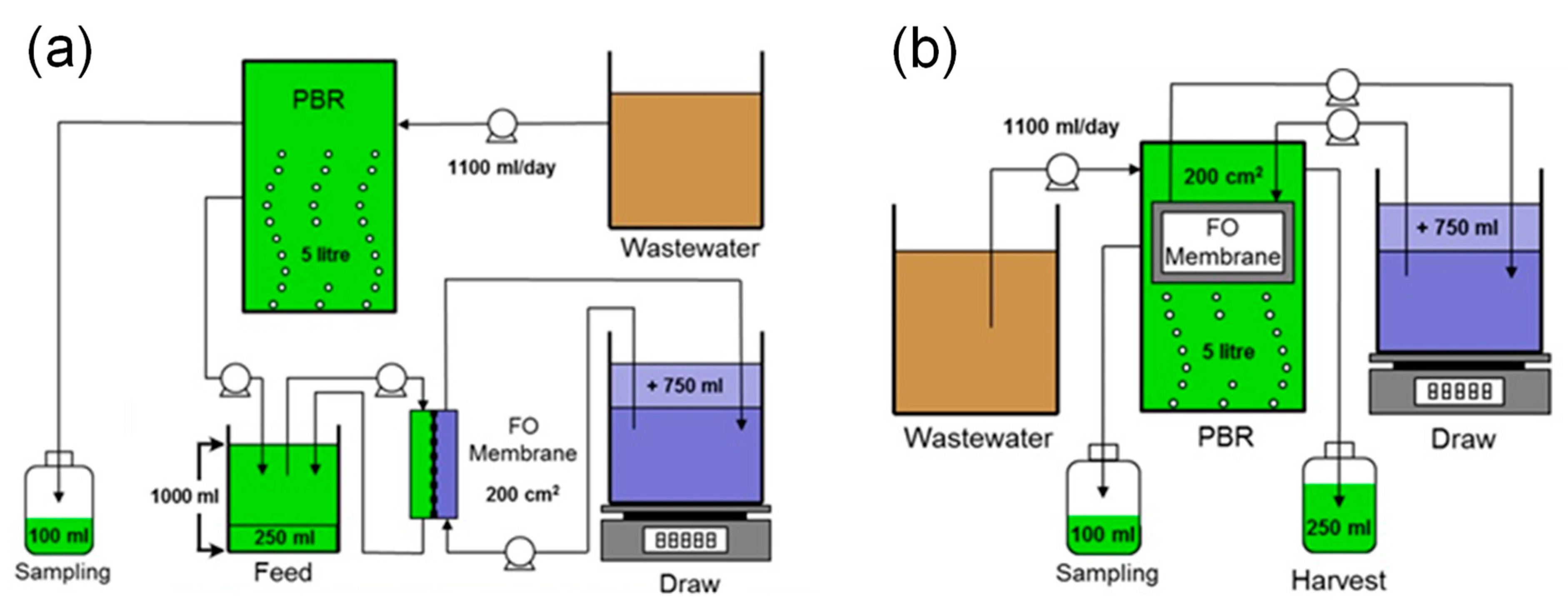
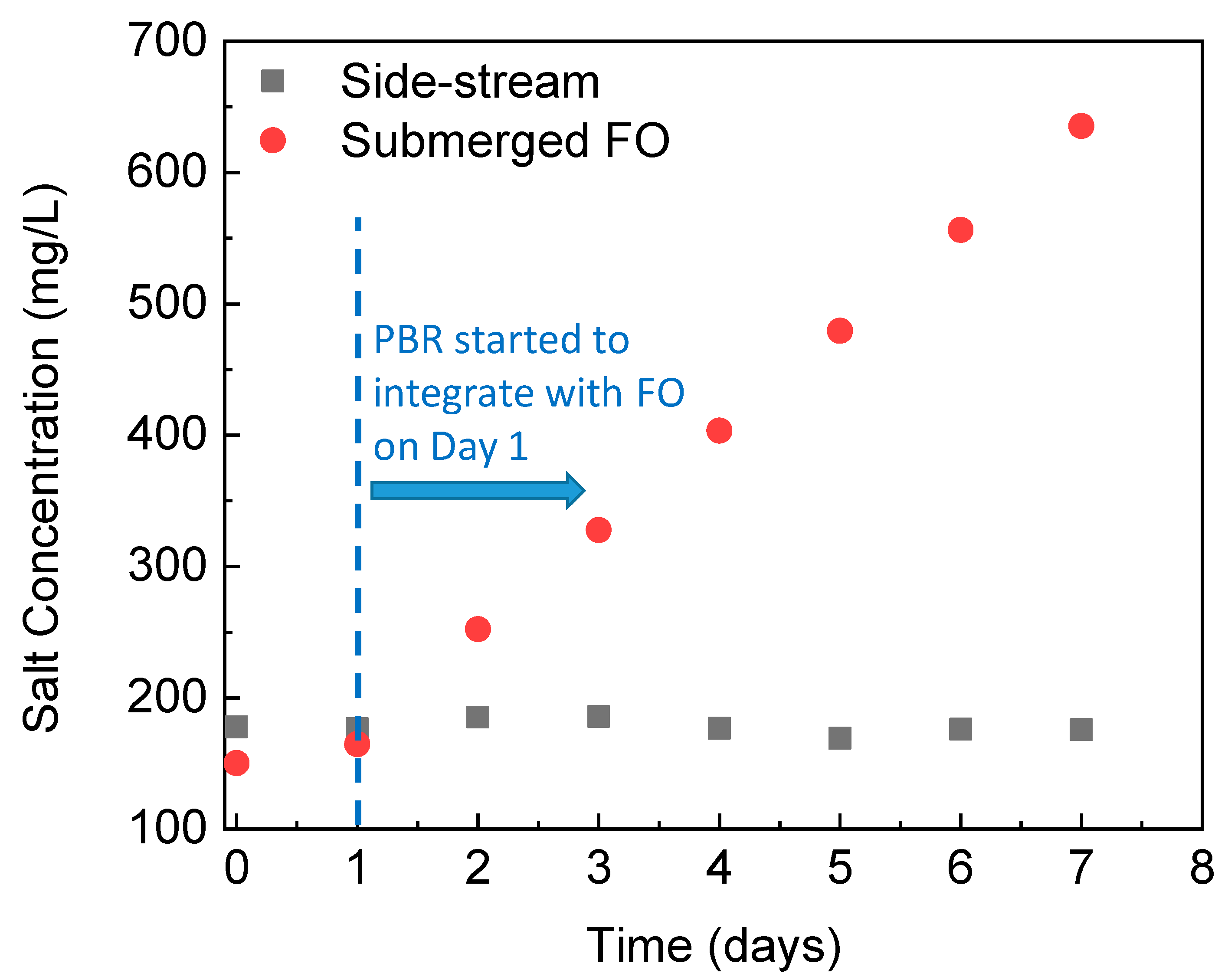

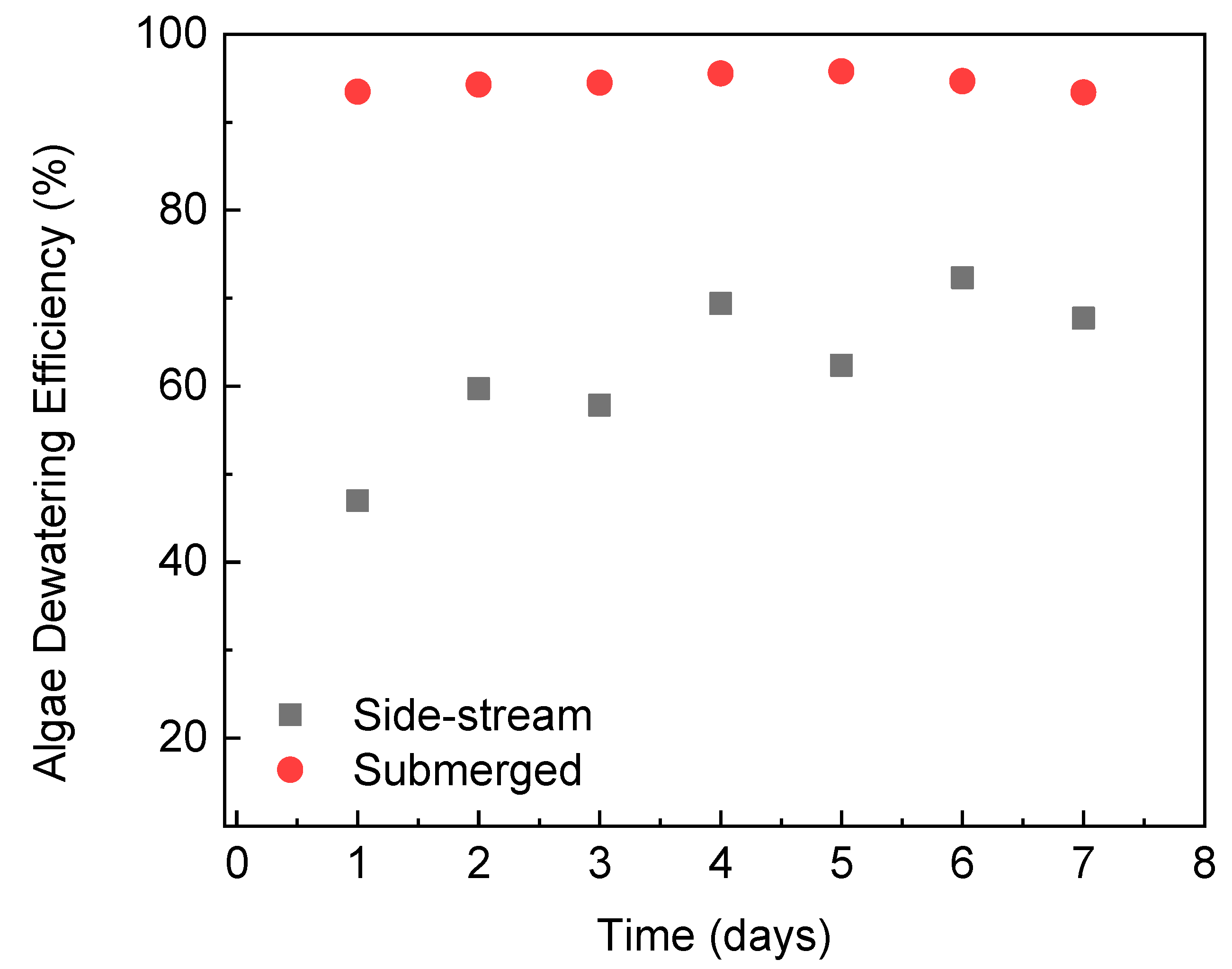
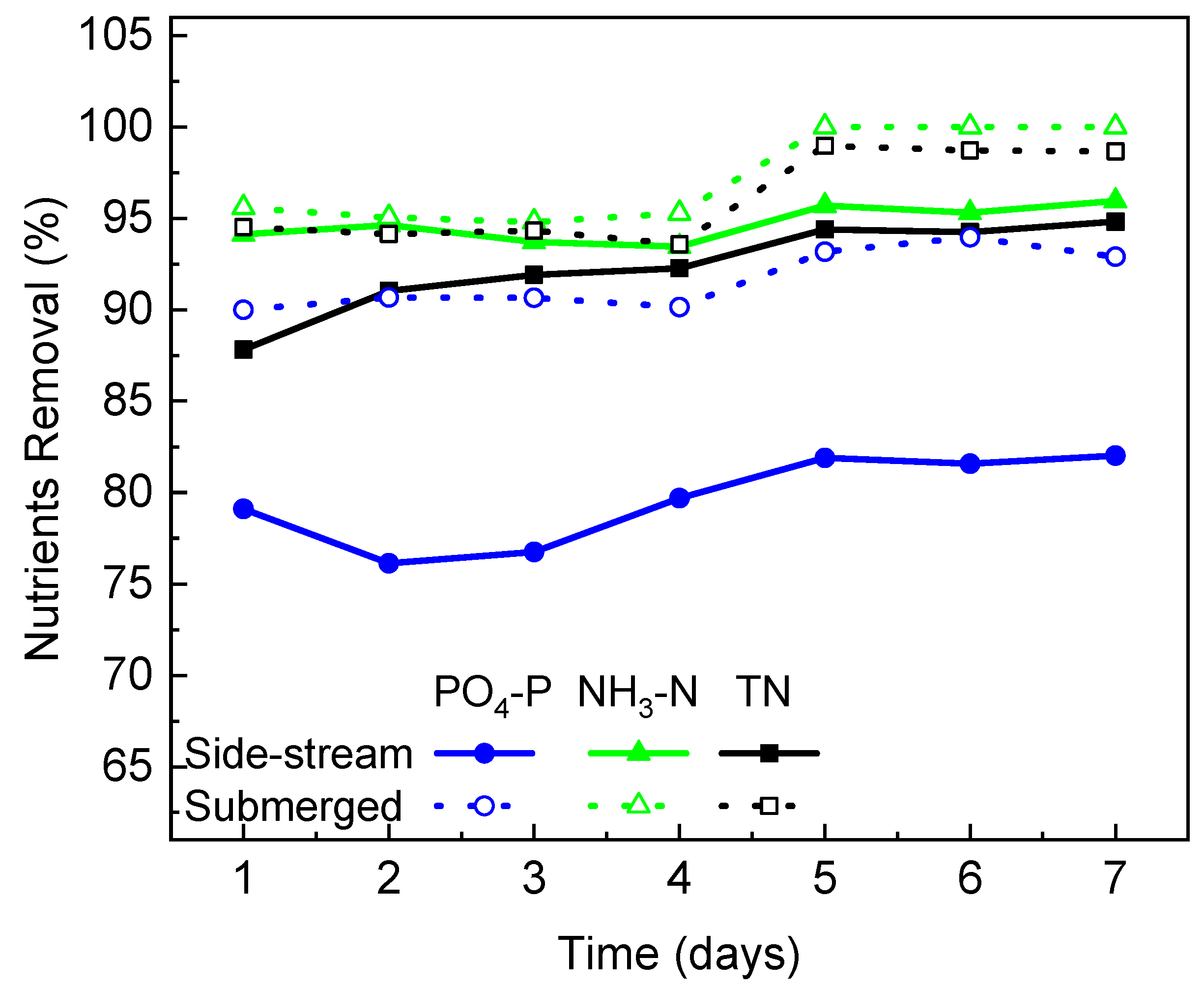
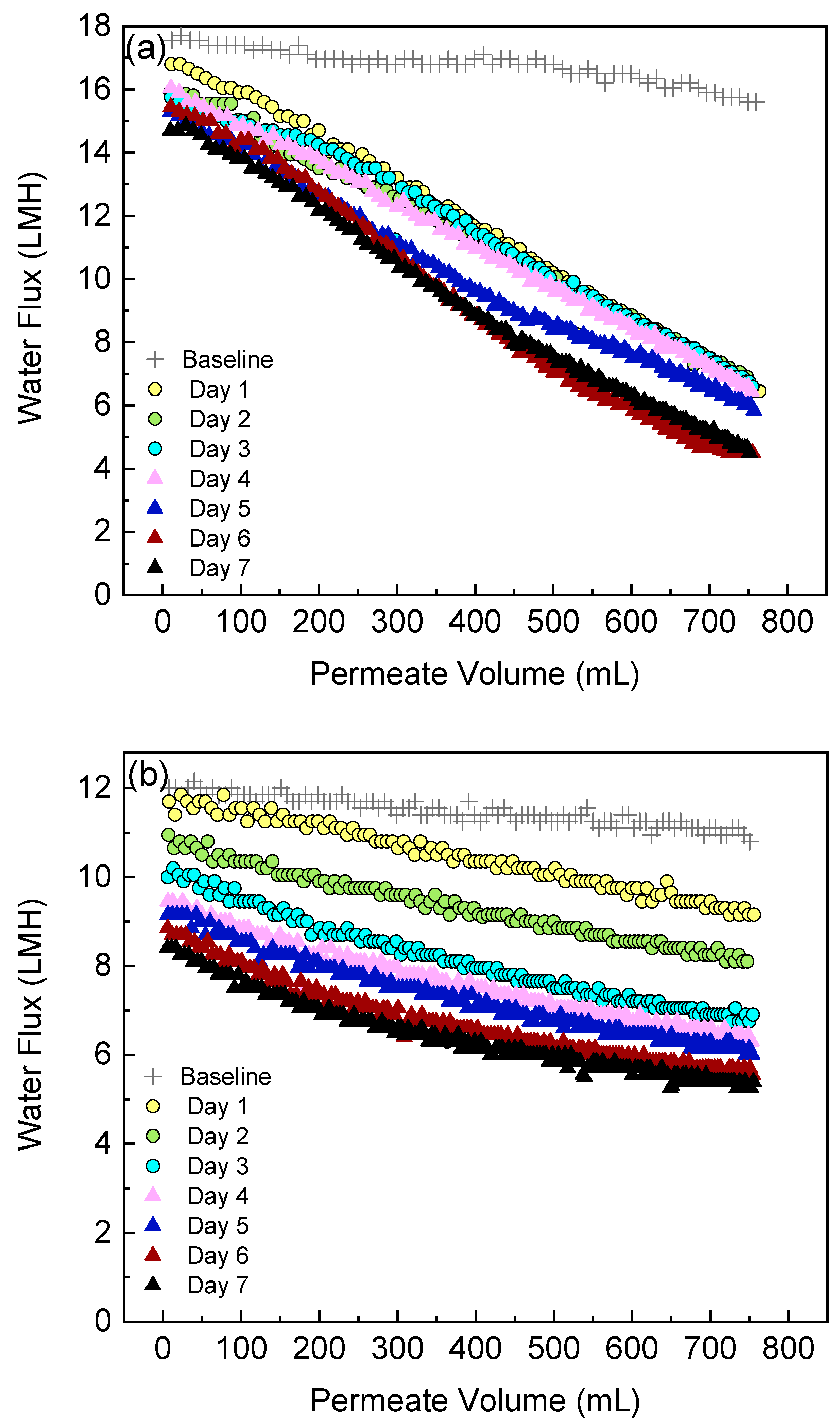

| Component | Concentration (mg/L) |
|---|---|
| K2HPO4∙3H2O | 30 |
| CaCl2∙2H2O | 7.5 |
| Cr(NO3)3∙9H2O | 1.125 |
| CuCl2∙2H2O | 0.75 |
| MnSO4∙H2O | 0.15 |
| NiSO4∙6H2O | 0.375 |
| PbCl2 | 0.15 |
| ZnCl2 | 0.375 |
| Urea | 120 |
| NH4Cl | 15 |
| CH3COONa∙3H2O | 168.75 |
| Peptone | 22.5 |
| MgHPO4∙3H2O | 37.5 |
| FeSO4∙3H2O | 7.5 |
| Starch | 157.5 |
| Milk powder | 150 |
| Dried yeast | 67.5 |
| Soy oil | 37.5 |
Publisher’s Note: MDPI stays neutral with regard to jurisdictional claims in published maps and institutional affiliations. |
© 2022 by the authors. Licensee MDPI, Basel, Switzerland. This article is an open access article distributed under the terms and conditions of the Creative Commons Attribution (CC BY) license (https://creativecommons.org/licenses/by/4.0/).
Share and Cite
Larronde-Larretche, M.; Jin, X. The Influence of Forward Osmosis Module Configuration on Nutrients Removal and Microalgae Harvesting in Osmotic Photobioreactor. Membranes 2022, 12, 892. https://doi.org/10.3390/membranes12090892
Larronde-Larretche M, Jin X. The Influence of Forward Osmosis Module Configuration on Nutrients Removal and Microalgae Harvesting in Osmotic Photobioreactor. Membranes. 2022; 12(9):892. https://doi.org/10.3390/membranes12090892
Chicago/Turabian StyleLarronde-Larretche, Mathieu, and Xue Jin. 2022. "The Influence of Forward Osmosis Module Configuration on Nutrients Removal and Microalgae Harvesting in Osmotic Photobioreactor" Membranes 12, no. 9: 892. https://doi.org/10.3390/membranes12090892
APA StyleLarronde-Larretche, M., & Jin, X. (2022). The Influence of Forward Osmosis Module Configuration on Nutrients Removal and Microalgae Harvesting in Osmotic Photobioreactor. Membranes, 12(9), 892. https://doi.org/10.3390/membranes12090892







